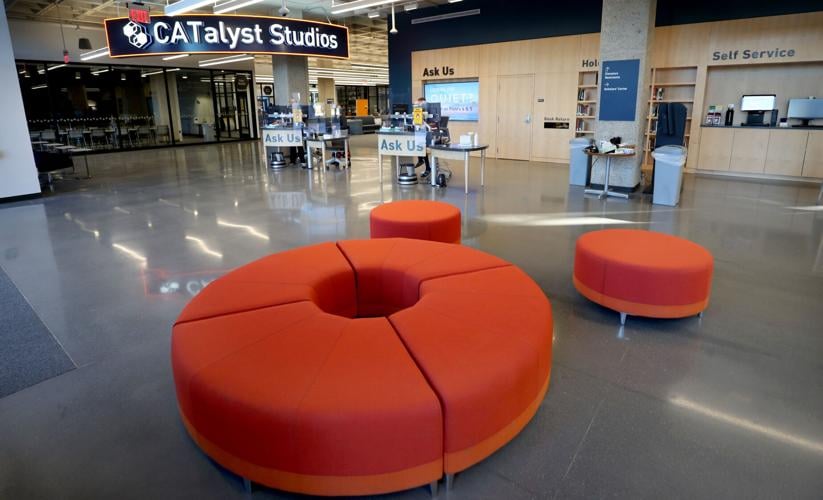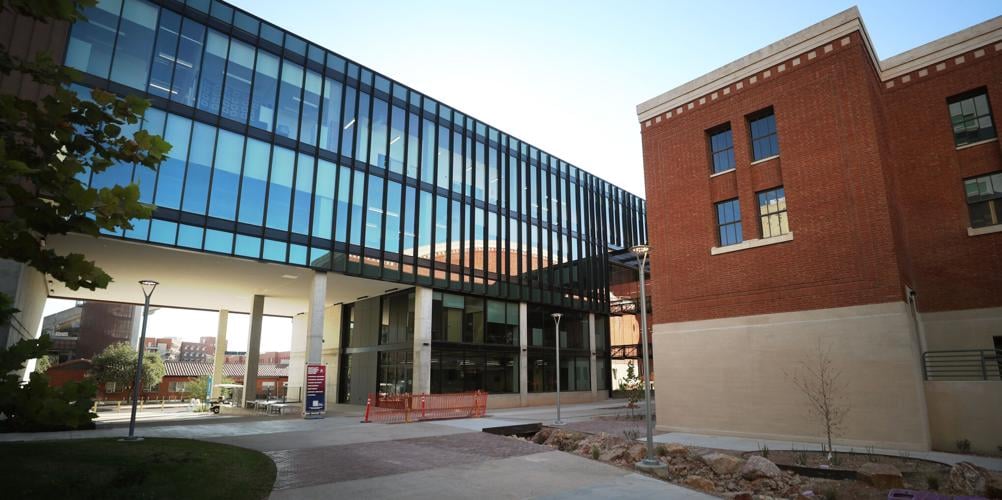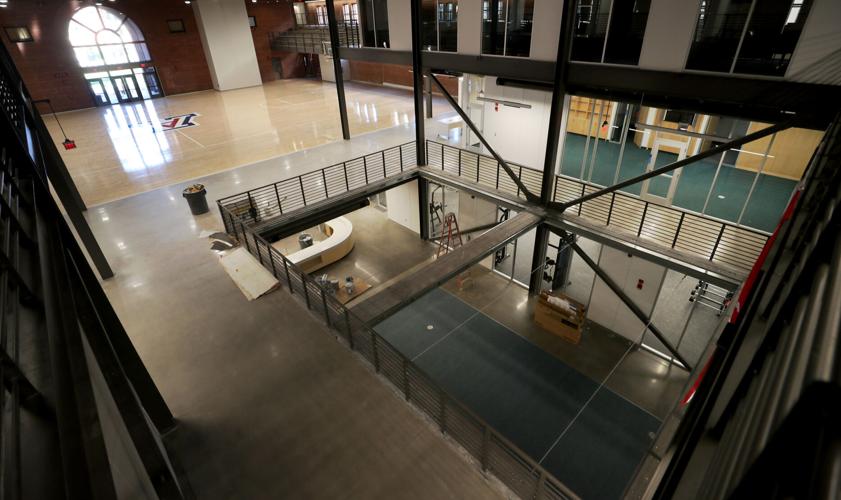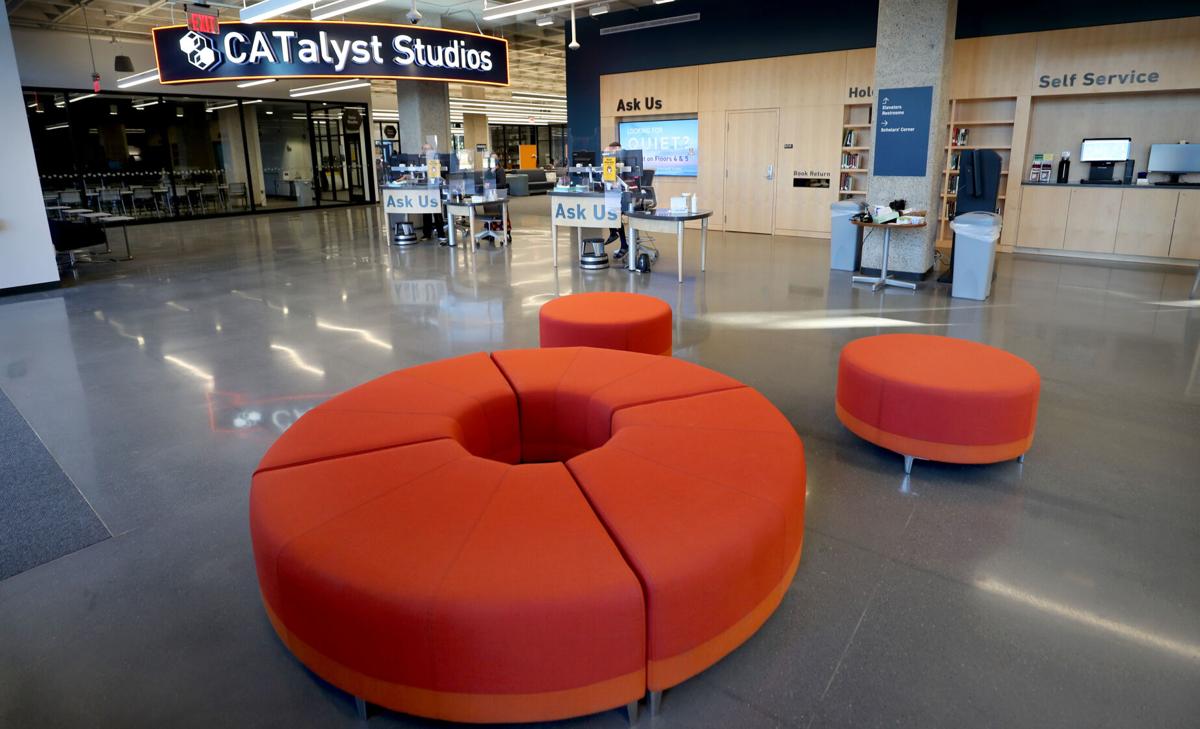When University of Arizona students return from holiday break, they’ll be able to meet some of their health and wellness needs at the newly renovated Bear Down Gymnasium.
The renovation, which is set for completion in January, is the final piece of an $81 million buildout at the UA called the Student Success District. Construction of the massive project, which aims to seamlessly connect students with all of the resources they need to succeed in college and beyond, got underway in early 2019.
Three years later, that $81 million has gone toward renovating the old gym — which opens next semester with a restored basketball court, new tutoring rooms, a Campus Health satellite office, and spaces to exercise, among other services — and connecting it with the nearby and newly renovated Main Library and the Albert B. Weaver Science-Engineering Library.
The success district also includes a fourth — and brand new — building: the Bartlett Academic Success Center, which is connected to the gym via a pedestrian bridge. It opened last fall and is now the centralized location where students can access academic support resources through Think Tank and SALT tutoring centers, UA Thrive Center, Student Engagement and Career Development, Student Success and Academic Retention.

The new Bartlett Academic Success Center connects to Bear Down Gym via a sidewalk and two elevated walkways, part of the newly constructed Student Success District at the University of Arizona.
The Bartlett Center has also become an academic advising hub for students enrolled in the colleges of humanities, science and social and behavioral sciences.
Ezequiel Jimenez, a senior at the UA, works part-time at the Bartlett Center as a peer mentor for first-generation students through Thrive Center. When he thinks back to his first couple of years on campus as a first-generation student — when the Student Success District was still a vision under construction — he wishes he’d had a place like the district.
Key resources in one place
Previously, the resources many students are looking for were scattered all over campus. Now, much of the career guidance and academic support the UA offers is located between the four buildings included in the one 9-acre district at the center of campus.
“That would have been a lot more helpful, especially as a first-generation student, because everything just feels so new to you and it’s all intimidating. Going around to look for something and not knowing where it is is enough to make you say ‘I’m not going to do this,’” Jimenez said. “One of the struggles for first-generation students is just getting started in their careers. Like, if they wanted to be a doctor, but don’t know any doctors in their life, that makes it hard to know what to do to achieve that goal.”
But now, if one of his mentees says they need help with tutoring or career advising, for instance, Jimenez just has to walk them down the hall or up the stairs to make it happen.
“It’s way more accessible,” he said. “There’s just not many excuses to not get that support.”
Elevating access to the tools students need to get the most out of their college education was one of the main drivers behind creating the district.
Shan Sutton, dean of UA’s libraries, said the university hopes bringing all of these services together and locating them right alongside the libraries will aid in both recruitment of new students and retention of current students.
“We’re thinking prospective students will have a confidence level that what they need is readily available right there at the district and will make the UA more attractive to them,” Sutton said. “We also believe the same is true for students who are already enrolled. Centrally locating these services and programs makes students more aware that they exist. They may be going to one office or program, but they’ll pass by five others on the way that they may not have even known about.”

A new opening has been installed in the floor of Bear Down Gym, which has a restored basketball court, new tutoring rooms and a Campus Health satellite office.
The two libraries that make up part of the district have also been renovated with a fresh approach to experiential learning in mind. The libraries still have plenty of physical books and quiet study spaces, but now they also have spaces for students to freely experiment with 21st century equipment, like 3D printers, laser cutters and podcast studios, and engage in spirited discourse and study sessions with their peers.
In addition to those material supports, architects of the project also delivered on two commodities students surveyed about the project said they desperately wanted: more natural light and outdoor seating.
“The science and engineering library was a dismal building with no light. There was a five-story brick wall on the east face of that building and we cut an enormous hole that brings light to that library, but also physically connects it to the Bear Down Gym,” said Corky Poster, an architect and principal designer with the Tucson-based firm Poster, Mirto and McDonald, which partnered with Sundt Construction to make up the design build team for the project.
“We’re very proud of that hole,” Poster added.

The Main Library's Tech Toolshed offers students a chance to get hands-on with 3D printers, computers, microphones and cameras.
Holistic concept
And the top brass at the UA is also proud of the completion of the district. They’re billing it as an innovative, one-of-a-kind project focused on educating students as whole individuals and equipping them with the interdisciplinary critical thinking skills to translate what they learn in the classroom into real-world problem-solving.

A staircase connecting Floors 1 and 2 at the Main Library offers casual study space and seating.
“It’s a holistic approach,” Nina Bates, director of operations and strategic initiative for the provost’s office, said. When she was tasked with overseeing the project, she looked to see what other universities had done in the way of elevating access to student supports, but none had done it to the extent the UA has.
“Most of them were just one building,” Bates said. “Ours is a 9-acre area dedicated specifically to student success. It is pretty significant.”
Photos: Student Success District at University of Arizona
Student Success District, UA, 2021
Updated
CATalyst Studios in the Main Library feature numerous technical workspaces, tools and equipment for students, part of the newly constructed Student Success District at the University of Arizona.
Student Success District, UA, 2021
Updated
The third floor of the Bartlett Academic Success Center, part of the newly constructed Student Success District at the University of Arizona. Students wanted more natural light in the school's buildings and many of the newly built features are floor to roof windows.
Student Success District, UA, 2021
Updated
Open floor plan and natural light in the remodeled Collaborative Learning Space at the Weaver Science-Engineering Library, part of the newly constructed Student Success District at the University of Arizona.
Student Success District, UA, 2021
Updated
New open space and natural light as the result of the recent remodel of the entrance to Main Library, part of the newly constructed Student Success District at the University of Arizona.
Student Success District, UA, 2021
Updated
The new Bartlett Academic Success Center runs to the south of Bear Down Gym and connects to the older building via a sidewalk and two elevated walkways, part of the newly constructed Student Success District at the University of Arizona.
Student Success District, UA, 2021
Updated
A new opening installed in the floor of Bear Down Gym, part of the newly constructed Student Success District at the University of Arizona.
Student Success District, UA, 2021
Updated
The Tech Toolshed offers students a chance to get hands-on with several cutting edge technical tools including 3D printers, computers, microphones and cameras, part of the newly constructed Student Success District at the University of Arizona.
Student Success District, UA, 2021
Updated
The Monumental Staircase offers casual study space and seating for lectures and speeches in Main Library, part of the newly constructed Student Success District at the University of Arizona.
Student Success District, UA, 2021
Updated
The new workrooms in Main Library feature overlays on the windows of a map of Pima County, part of the newly constructed Student Success District at the University of Arizona, Tucson, Ariz., December 16, 2021.
Student Success District, UA, 2021
Updated
A return of a hardwood gym floor to Bear Down Gym part of the newly constructed Student Success District at the University of Arizona. The remodel project also saved some of the original bench seats from the old gym.
Student Success District, UA, 2021
Updated
The center court floor, saved during the remodel, stands on a the wall just outside the new locker rooms at Bear Down Gym, part of the newly constructed Student Success District at the University of Arizona.
Student Success District, UA, 2021
Updated
The new offices for Support Outreach Success on the main floor of the new Bartlett Academic Success Center, part of the newly constructed Student Success District at the University of Arizona.
Student Success District, UA, 2021
Updated
Two story windows are in place of what once was a solid wall and makes up the new east side entrance to the Weaver Science-Engineering Library, part of the newly constructed Student Success District at the University of Arizona.
Student Success District, UA, 2021
Updated
Dozens of mobile partitions with writing surfaces for group study sessions are a new addition to the Weaver Science-Engineering Library, part of the newly constructed Student Success District at the University of Arizona.
Student Success District, UA, 2021
Updated
Bear Down gym, center with a new entrance and connection to the new Bartlett Academic Success Center to the south, at left, and with Main Library to the east, right, is the centerpiece of the newly constructed Student Success District at the University of Arizona. The new district encompasses several acres and interconnects Bartlett, Main Library, Bear Down and Weaver Science-Engineering Library.
Student Success District, UA, 2021
Updated
Main Library has new entrance on the west side, connecting it to Bear Down Gym, part of the newly constructed Student Success District at the University of Arizona.








